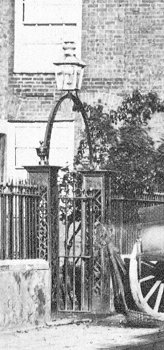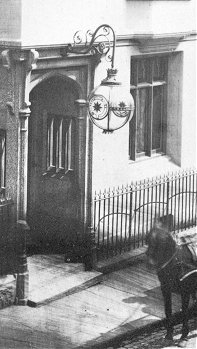| Street lighting in the form of oil lamps was
first installed in Wolverhampton town centre in the late 1770s.
On the 20th June 1777 the Commissioners met and decided that
they "are open to tenders for glass lamps for lighting the town,
also lamp irons and oil and lighting". By 1800 a lamp was
positioned at every corner and over the doorway of every Inn.
The streets were dimly lit and remained so for over twenty years
until the oil lamps were replaced by the far superior gas
lights. |
|

A typical gas light. |
In the late 18th century and early 19th
century a number of Acts of Parliament were passed to make towns
safer and healthier places to live. The Town Improvement Acts
compelled towns which came under them, to clean, light, pave,
and make the streets safe, and take other steps to promote a
town’s health, such as the provision of a pure water supply.
By 1800 about 200 such Acts had been passed, including two
for Dudley and Stourbridge. When the 1814 Act for Wolverhampton
came into force the Commissioners advertised for someone to take
care of the lighting. The town was to be lit between the months
of November to March, except for eight nights at or around a
full moon. There were 640 oil lamps with double burners, which
were kept alight from sunset until four o’clock in the morning.
After the invention of gas lighting the Improvement Acts
referred specifically to lighting by gas. Such Acts were passed
for Wolverhampton in 1820, Dudley in 1821 and Stourbridge in
1825. |
|
In 1817 Aaron Manby offered to light Wolverhampton with gas. The
offer was not taken up because some of the Commissioners had already
realised that profits could be made from such a scheme. The
Commissioners took no further action in the matter and future of gas
lighting in the town was left to private enterprise.
The first gas lighting in the town was provided by Mander, Weaver and
Company for their own works and for some of the manufacturing processes
which required the application of heat. The exact date of the
installation is uncertain but this must have been one of the earliest
installations in the area.
In November 1819 fifty seven subscribers purchased shares in a new
venture called ‘The Wolverhampton Gas Light Company’. The company was
incorporated after an Act of Parliament which was passed on 27th
June 1820.
In the petition it stated that the 57 subscribers would fund
the venture and that the town of Wolverhampton was "a large and
populous place, and it would be of great advantage to the
inhabitants there of, and to the public at large, if the streets
and other public passages and places were better lighted".
|

The type of lamp that was mounted over
entrances to public buildings. |
It also mentioned that "Inflammable air or gas,
being conveyed by means of pipes, may be safely and beneficially
used for lighting the several streets etc. and for lighting
shops, private houses and buildings, and the coke may be
beneficially employed as fuel in private house and
manufactures". The 57 subscribers included many well known
Wolverhampton people and 5 of the town’s Commissioners. The list
included the following:
| John Weaver and
Benjamin Parton Mander, paint manufacturers |
| Chrees and
Tompson, solicitors |
| Henry Hordern,
banker |
| William Ready
and William Ryton, constables |
| William Hanbury
Sparrow, ironmaster |
| Joseph Smart,
one of the founders of the Wolverhampton Chronicle |
| Richard Fryer,
banker and company treasurer |
| Harry Parkes,
Commissioner and company clerk |
| John Dixon, of
Ready and Dixon |
|

The fine lamp that hung over the door of
the Star & Garter Hotel. |
The company’s engineer was John Grafton who had
taken out patents for gas purification in 1818, 1819 and 1820.
The pipes were laid during the summer and autumn of 1820 by
the firm of Ready and Dixon.
The work had been completed by January 1821.
In the Wolverhampton Chronicle of 22nd
November, 1820 it mentioned that the company had promised to
supply customers with gas "of the purest quality without smell
or stain".
Two gasometers were ordered for the company’s gasworks which
were built in Horseley Fields and began production on 17th
September 1821. |
|

The location of Wolverhampton's first
gasworks.
|

|
|

|
|

|
| Return to
Distribution |
|
Return to
the beginning |
|
Proceed to
the Candlestick |
|